Hummingbirds are striking birds, with distinct colors and behaviors. They’re a fun bird to watch for, because so many of them willingly visit backyard feeders. Hummingbirds have their natural native ranges, but most of these birds are wanderers. They’ll travel far, far outside of their range in search of good food.
While the ruby-throated hummingbird is the most common in the state of Georgia, you can also many other beautiful species.
Hummingbirds are a New World group of birds, which means that they aren’t found in Asia, Europe, or Africa. Within North America, there are 16 species of hummingbirds. Of those, just two are common in Georgia, while nine others will rarely visit.
Here is the list of species of hummingbirds in Georgia:
- Ruby Throated Hummingbird
- Black-Chinned Hummingbird
- Allen’s Hummingbird
- Rufous Hummingbird
- Buff-bellied Hummingbird
- Calliope Hummingbird
- Broad-Bellied Hummingbird
- Anna’s Hummingbird
- Rivoli’s Hummingbird
- Mexican Violetear
- Green Breasted Mango Hummingbird
11 Types of Hummingbirds in Georgia
Hummingbirds visit every part of North America, but Georgia is lucky enough to see some species that usually stick to western parts of the country. Here are the eleven species to watch for:
1. Ruby Throated Hummingbird
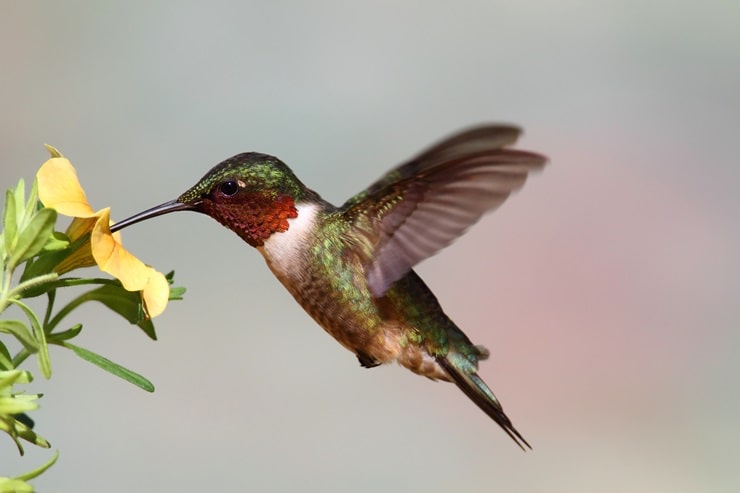
- Scientific name: Archilochus colubris
- Size: 2.8-3.5 inches long
- Weight: 0.1-.02 ounces
- Wingspan: 3.1-4.3 inches
Say “hello” to the most common – by far – hummingbird in all of Georgia. In fact, this is the only breeding hummingbird in the eastern part of North America, and the only non-migratory hummingbird in the state. That means they nest in Georgia, but no other hummingbirds do.
The male birds are easy to identify by their bright red throats. If you notice a bird that looks somewhat like a ruby-throated, but the throat looks dark red, it’s likely just because the feathers aren’t in good light. Wait until the sunlight hits them and you’ll see that shining bright throat.
Otherwise, these birds are emerald or golden-green on their backs and grayish-white on the underside. The beaks are black.
These bold birds are frequent visitors to feeders and if you have the chance to watch their antics, take it. They are incredibly agile. They can stop instantly in the air, hover up, down, side-to-side, and backward. Not only do they feed at feeders and in tubular flowers, but they’ll snatch insects out of the air or from webs, as well.
These generalists live in parks, gardens, backyards, meadows, fields, forests, and woodlands.
They fly away in the fall to winter in Central America and they actually fly across the Gulf of Mexico in one single flight without stopping. Very impressive!
When Do They Arrive In and Leave Georgia?
Ruby-throated hummingbirds are Georgia’s only non-migratory hummingbirds.
You can see them most often during the breeding season in all of Georgia, which takes place from March to July, but they might be found any time of year.
2. Black-Chinned Hummingbird

- Scientific name: Archilochus alexandri
- Size: 3.5 inches long
- Weight: 0.1-.02 ounces
- Wingspan: 4.3 inches
Black-chinned hummingbirds get their name from the black throat with an iridescent purple base that males have. Females, on the other hand, have pale throats, along with white tips on their outer tail feathers.
Some hummingbirds stand out because of their brilliant coloring, but black-chinned are just a bit more subdued. They only have a thin strip of iridescent purple on the chin, but otherwise, they’re dull metallic Creek with a dull grayish-white best. Females have pale throats and males have black throats. Both have black bills.
These petite birds are frequent visitors to hummingbird feeders, where they dart in and out taking deep sips. They also sit on top of telephone wires and treetops to survey their territory. If a wandering hummingbird tries to enter their territory, the original bird will chase them off. Males can even dive up to 100 feet at a time to defend their territory and show off to females during the breeding time.
They live anywhere they can find a safe spot to nest, which makes them generalists. They might live in a forest, a desert, or in urban shrubs. Recent surveys show that their range has been shrinking, with populations in Louisiana and Wyoming becoming threatened.
Breeding season starts in the early spring and they build their nests in April and May, with a second nesting period in July. The males court the females with dramatic diving displays and they breed throughout western North America. They’ll also visit the Gulf Coast during the winter. They nest in the spring and are one of the more common hummingbirds to find in their native range.
These are frequent visitors to feeders and they’ll snag any insects they find nearby, including ants that hang out on your feeder. They also eat the sap from flowers.
Hang a feeder in your yard to increase your chances of seeing them, and plant their favorite foods, including tree tobacco (Nicotiana glauca), scarlet larkspur (Delphinium cardinale), and desert ocotillo (Fouquieria splendens).
When Do They Arrive In and Leave Georgia?
Black-chinned hummingbirds only visit Georgia during the winter and even then they’re fairly rare. Look for them from December through March.
3. Allen’s Hummingbird

- Scientific name: Selasphorus sasin
- Size: 3.5 inches long
- Weight: 0.1 ounces
- Wingspan: 4.3 inches
With its bold, copper-orange throat and sides and green back, it’s easy to spot these cheerful-looking hummingbirds. They love to flit from flower to feeder and they snatch insects from the air as they fly.
They live in the chaparral of coastal regions from California to Southern Oregon, but these petite fliers are hardy travelers. They fly from their breeding ground all the way down to southern Mexico, where they hang out during the non-breeding season. They stay in Southern California year-round, as well.
Once in a while, they’ll venture along the Gulf Coast and may end up as far east as Florida.
They’ll eat at hummingbird feeders but they also love flowers and will dine on insects.
The females nest and raise their young from February to August, though non-migratory birds will nest in California from October through June.
When Do They Arrive In and Leave Georgia?
Look for this bright bird during the winter along the coast of Georgia.
4. Rufous Hummingbird
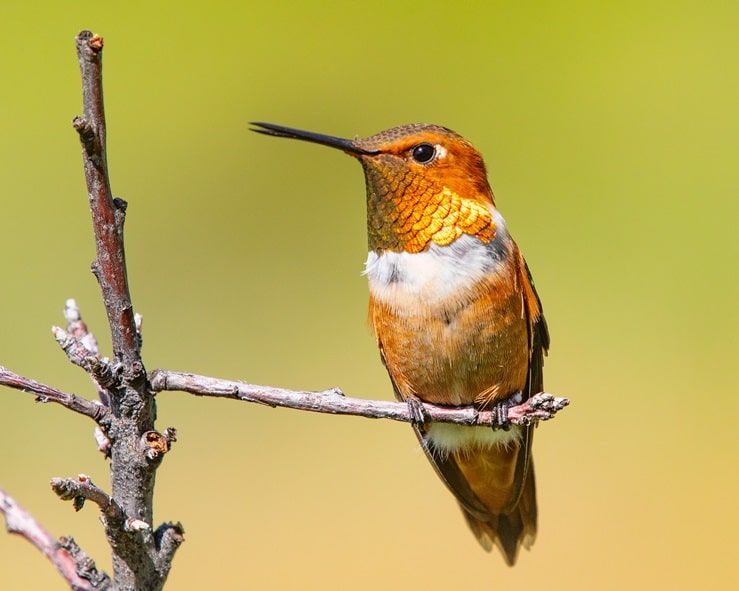
- Scientific name: Selasphorus rufus
- Size: 2.8-3.5 inches long
- Weight: 0.1-.02 ounces
- Wingspan: 4.3 inches
Rufous means “reddish” and that’s what these birds are. When the sunlight hits them, they glow like a lump of burning coal, with a reddish back and a vivid red throat. The females have a little bit of green on their tails and flanks, plus a little spot of orange on their throats.
Even though these birds might just be visiting an area as they migrate, they’re fierce defenders of the area they are in. They will tirelessly chase off any hummingbird that dares come near. They’ll even chase off bigger birds of other species and they’ll dive-bomb humans who come too close to their feeder or nest.
Like ruby-throated hummingbirds, they’re incredibly agile and will feed from feeders and tubular flowers, as well as snatch insects from the air or spider webs. They live in backyards, forests, meadows, and parks.
In the spring, they leave to their breeding grounds on the west coast where they stay from April to July.
When Do They Arrive In and Leave Georgia?
These hummingbirds aren’t common in Georgia. They arrive in the state during the winter and they leave in the spring.
5. Buff Bellied Hummingbird
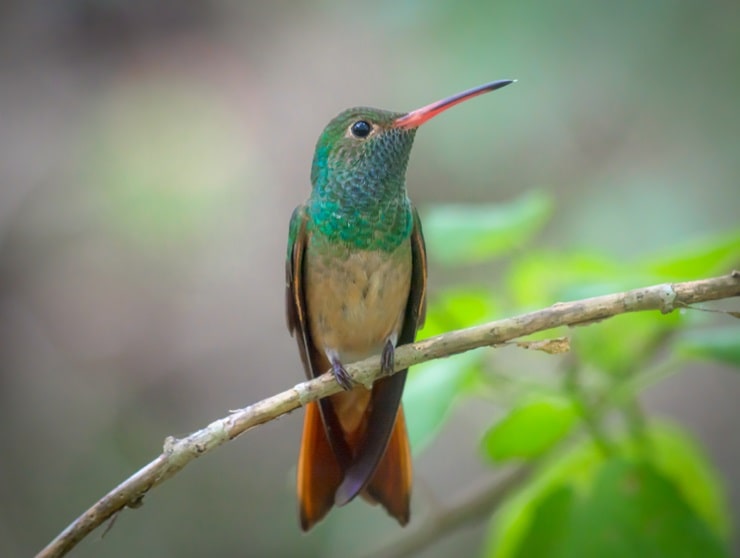
- Scientific name: Amazilia yucatanensis
- Size: 3.9-4.3 inches long
- Weight: 0.14-0.18 ounces
- Wingspan: 5.75 inches
Buff-bellied hummingbirds don’t live in Georgia. They primarily live along the Gulf Coast, with permanent colonies in Mexico and parts of South America, and migrant breeding populations in Texas, Louisiana, Mississippi, and Alabama. Every so often, they’ll venture over to Georgia. Rarely, they’ll hang out along the western coast of the state.
These birds have bright red bills with black tips and buff bellies, which sets them apart from other hummingbirds. When the sun hits their throats, you can see the bright blue-green feathers glisten and shine.
It mostly lives in desert landscapes and will visit suburban yards, especially if there is a feeder present. It uses its long tongue to lap sap out of flowers and feeders, but it’s also known to snatch insects out of the air when it gets the chance.
Because it’s larger than many other hummingbirds, it can use its size to drive off competition. You’ll often see it chasing away other hummingbirds.
This bird only breeds in Texas, and it’s actively nesting and raising its young from March until August.
When Do They Arrive In and Leave Georgia?
These birds start arriving in the fall and stick around through early winter.
6. Calliope Hummingbird
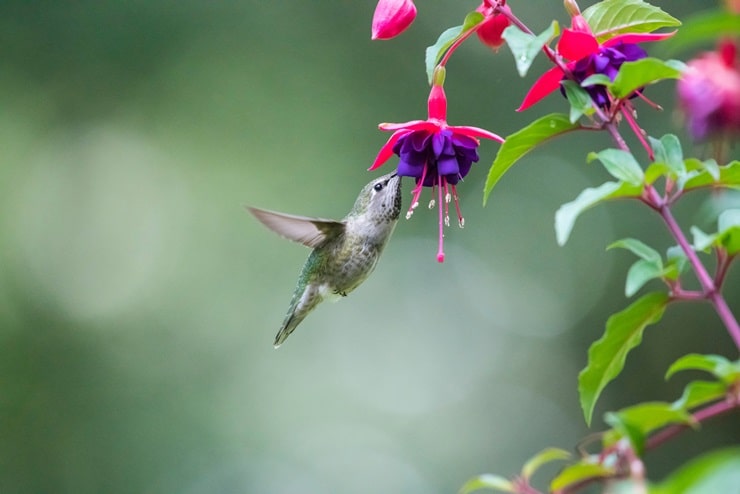
- Scientific name: Selasphorus calliope
- Size: 2.8-3.9 inches long
- Weight: 0.07-0.1 ounces
- Wingspan: 4.3 inches
Calliope hummingbirds are very rare in Georgia, but you might get lucky and see one of these non-natives to the state. They’re far more common in the Pacific Northwest, California, parts of the west, and Canada.
They breed in western Canada, Oregon, Washington, California, Nevada, Idaho, Montana, Wyoming, and parts of Utah and they spend the non-breeding season in Mexico.
The males of these beautiful birds have magenta feathers on their throats and both females and males have iridescent green feathers on their backs. The male courts the female by diving in an acrobatic u-shape while making a buzzing sound with his tail feathers. They breed from April to June.
While they will eat from feeders, they tend to be a bit more timid than some other hummingbirds. They aren’t afraid of other birds, though. They’re even known to chase away red-tailed hawks.
They’ll eat the sap from flowers, but they’re also fond of the sap on trees left by sapsuckers and they’ll also eat insects and spiders.
When Do They Arrive In and Leave Georgia?
These tiny birds, the smallest hummingbirds in North America, might arrive in the fall and stick around through early winter.
7. Broad-Billed Hummingbird
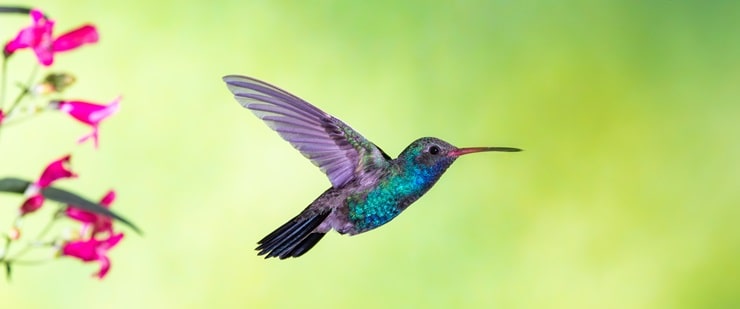
- Scientific name: Cynanthus latirostris
- Size: 3.5 inches long
- Weight: 0.1 ounces
- Wingspan: 4.3 inches
The broad-billed hummingbird makes Mexico and a few parts of the Southern US such as Arizona and New Mexico its home. It stays year-round in Mexico, but ventures further north during the breeding season.
This bird has a long, narrow, straight bill and a tail with a notch at the center, which helps you tell it apart from other species. They also stand out because of their shimmering green bodies and blue throats on the males. The bills are red with a black tip.
They eat insects as well as the nectar from flowers and feeders.
These birds create their nests in mountain canyons and then head to higher elevations to forage after raising their young. The males court the females with a swooping display that has been compared to the swinging of a hypnotist’s watch.
There are five sub-species but only the magicus sub-species lives in the US.
When Do They Arrive In and Leave Georgia?
Since these are rare visitors, we don’t really know when they’ll come and visit, so keep an eye out year-round, but especially during the winter.
8. Anna’s Hummingbird
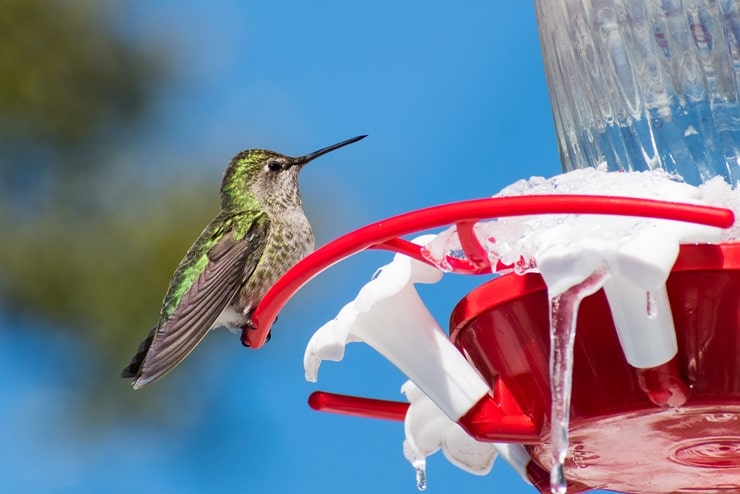
- Scientific name: Calypte anna
- Size: 3.9 inches long
- Weight: 0.1-0.2 ounces
- Wingspan: 4.7 inches
If you live along the Pacific coast, then no doubt you’ve seen the stunning Anna’s hummingbird. They’re one of the most common species in the region and they live there all year long. They’ll also travel inland a bit during the breeding season and some will migrate to Mexico during the non-breeding season.
Look for the greenish-gray birds with iridescent feathers. Males have reddish-pink chins and heads.
When they’re breeding, the males will swoop down up to 130 feet, making a buzzing noise with their tail feathers in an attempt to impress the females.
These birds are bold and curious and will come right up to humans to check them out. They’ll eat at feeders, snatch insects, and suck the sap of tubular flowers.
When Do They Arrive In and Leave Georgia?
If you live in Georgia, it’s the non-breeding season of winter that you might be able to spot them.
9. Rivoli’s Hummingbird
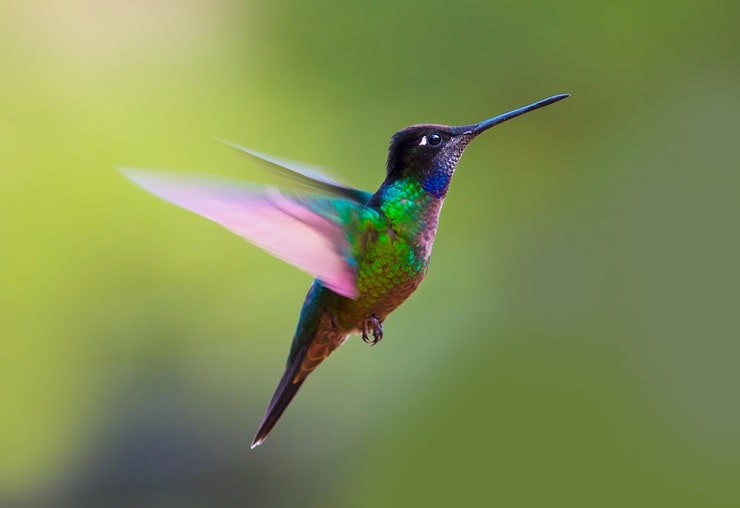
- Scientific name: Eugenes fulgens
- Size: 4.3-5.5 inches long
- Weight: 0.2-0.35 ounces
- Wingspan: 7.1 inches
Rivoli’s used to be called “magnificent hummingbirds,” and it’s plain to see why. They’re quite large for a hummingbird and they have unique coloring. The males are black with bold green highlights, violet crowns, and emerald throats. Females are less showy, with green and gray coloring.
These agile hunters will snatch insects out of the air and suck the sap out of tubular flowers. They prefer higher elevations, so you won’t see them as often on the coast, but they’re talented travelers, so you never know when they’ll pop up.
Normally, they live in Mexico but they will head up to New Mexico and Arizona during the breeding season. Now and then, they’ll travel to far reaches like Florida and Georgia.
When Do They Arrive In and Leave Georgia?
Look for these large hummingbirds during the winter.
10. Mexican Violetear Hummingbird
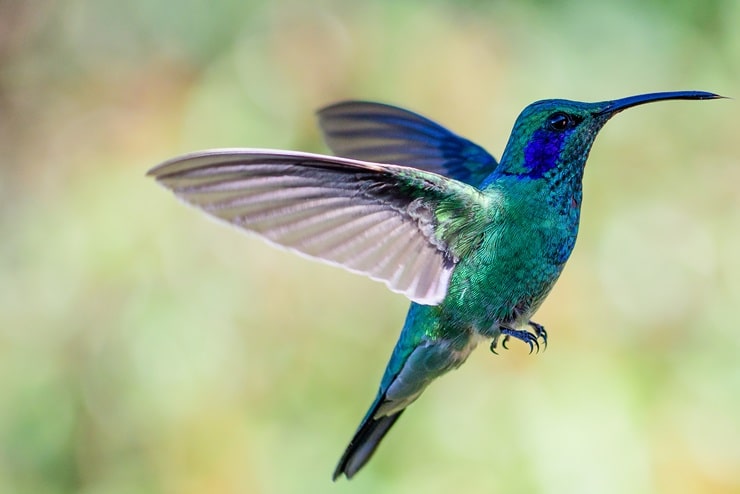
- Scientific name: Colibri thalassinus
- Size: 5.25 inches long
- Weight: 0.21 ounces
- Wingspan: 4.25 inches
Formerly known as the green violet-eared hummingbird, these are large for hummingbirds and can be nearly five-and-a-half inches long. Combined with their bright green bodies and violet streaks on the chest and cheeks, it’s easy to spot them as they flit about pine forests and roadsides.
They will visit birdfeeders, but they like to stay hidden as they eat, so if your feeder is out in the open they might not hang out much.
Their populations are concentrated in the southwest US and all of Mexico down through parts of Central America, but these birds are wanderers. You’ll find them as far north as Canada and occasionally across the midwest and Atlantic Coast. When they pop up in states like Georgia, it’s known as an “accidental” visit. It doesn’t mean that the bird didn’t know where it’s going, though. It’s just a term that birders use to describe a species that visits an area where they aren’t normally seen.
When Do They Arrive In and Leave Georgia?
There’s no telling when you might see a Mexican violetear, but watch for them primarily during the winter.
11. Green-Breasted Mango Hummingbird
- Scientific name: Anthracothorax prevostii
- Size: 4.7 inches long
- Weight: 0.25 ounces
- Wingspan: 6.25 inches
You’d probably never describe a hummingbird as chunky, but the green-breasted mango is relatively bulky. Its coloring somewhat resembles an oil slick, with iridescent black, green, purple, and blue feathers mottled throughout. Females have white tail corners.
These birds live in Mexico and Central America, but they are known to wander about. They’re often seen along the Gulf Coast of Texas, but rarely, they will venture even further north into states such as Louisiana, Georgia, and as far as North Carolina and even Wisconsin.
They’ll visit hummingbird feeders and they favor tropical flowers, especially those from large-flowered tropical trees like Inga and Erythrina species.
When Do They Arrive In and Leave Georgia?
Since they’re an accidental visitor to Georgia, you never know when they’ll show up, but winter is the most common time.
How to Attract Hummingbirds?
To attract hummingbirds to your yard, pick feeders that have a little perch so you can observe them holding still as well as in flight.
Contrary to common belief, the feeder doesn’t have to be red. These birds don’t care about the color, they just want a nice meal. You can grab a beautiful feeder with perches from Bolite. Don’t die the nectar, either. Clear nectar is totally fine.
You can also use pre-made nectar to attract them. Just be sure to change the nectar frequently and wash the feeder out with hot water and soap. When it’s really hot, you should change your feeder daily. During cooler weather, once a week is fine.
Feeders left uncleaned develop a mold that can kill hummingbirds.
You should also plant stuff like firebush, fuchsia, honeysuckle, trumpet vine, and powder puff trees. Hummingbirds love these.
Other bird species in Georgia:
Woodpeckers in Georgia
Owls in Georgia
